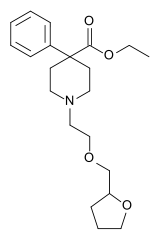Furethidine
Furethidine[1] is a 4-phenylpiperidine derivative that is related to the clinically used opioid analgesic drug pethidine (meperidine).[2]
 | |
| Clinical data | |
|---|---|
| Other names | ethyl 4-phenyl-1-(2-tetrahydrofurfuryloxyethyl)piperidine-4-carboxylate |
| ATC code |
|
| Legal status | |
| Legal status |
|
| Identifiers | |
| |
| CAS Number | |
| PubChem CID | |
| DrugBank | |
| ChemSpider | |
| UNII | |
| ChEMBL | |
| ECHA InfoCard | 100.017.451 |
| Chemical and physical data | |
| Formula | C21H31NO4 |
| Molar mass | 361.482 g·mol−1 |
| 3D model (JSmol) | |
| |
| |
| (verify) | |
Furethidine is not currently used in medicine and is a Class A/Schedule I drug which is controlled under UN drug conventions. It has similar effects to other opioid derivatives, such as analgesia, sedation, nausea and respiratory depression.[3] In the United States it is a Schedule I Narcotic controlled substance with the ACSCN of 9626.[4]
References
- GB Patent 797448
- Maul C, Buschmann H, Sundermann B. Opioids: 3.3 Synthetic Opioids. Analgesics 2005; 159-169. ISBN 978-3-527-30403-5
- Cahal DA, Dare JG, Keith D. A Sequential Trial of Analgesics in Labour. International Journal of Obstetrics and Gynaecology 1961; 68(1): 88–93.
- http://www.deadiversion.usdoj.gov/schedules/orangebook/d_cs_drugcode.pdf, pp. 13, accessed 23. January 2016
This article is issued from Wikipedia. The text is licensed under Creative Commons - Attribution - Sharealike. Additional terms may apply for the media files.